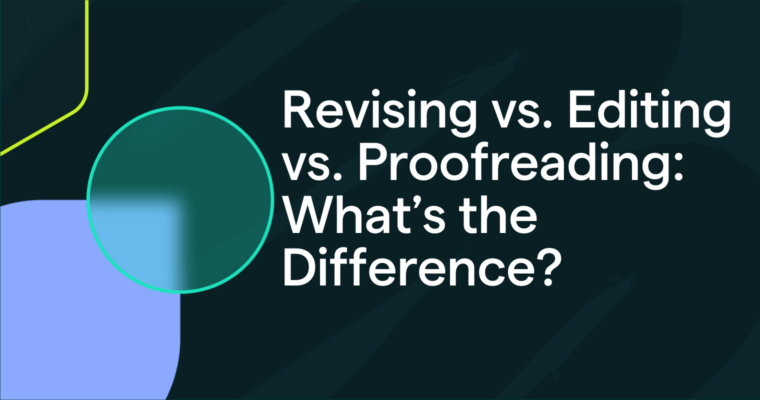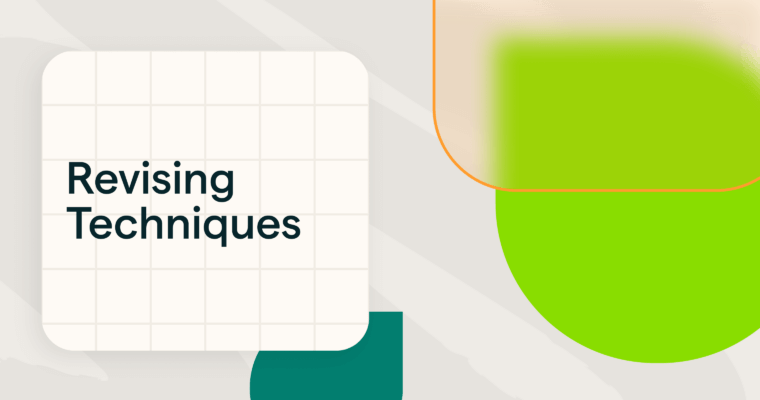
Revising your writing can seem overwhelming, but approaching it in clear, manageable steps makes the process more effective and less stressful. Revision comes before editing or proofreading. While those later stages focus on fixing grammar, punctuation, and typos, revision is where you tackle the big picture: your structure, clarity, and the flow of ideas.
Think of revision as your opportunity to transform a rough draft into clear, compelling writing. It’s when you take a step back and ask: Is my message coming through clearly? Does every part support it? Will readers understand and stay engaged?
By tackling revision before you worry about surface-level changes, you can ensure your writing has a strong foundation. Once that’s in place, you can begin polishing your sentences and catching mechanical errors through editing and proofreading.
Here are four practical steps to help you revise with purpose and confidence.
Table of contents
Steps for revising your writing
Step 2: Review the big picture
Step 3: Check the flow of ideas
Example of how to revise a paragraph
Steps for revising your writing
Turning a rough draft into clear, compelling writing starts with a solid revision strategy. Here’s how to tackle your draft with purpose and revise more effectively, one step at a time.
Step 1: Take a break
When you finish a draft, your mind is still closely tied to what you just wrote. This makes it harder to see issues objectively. That’s why the first step to effective revision is taking a break. Even a short pause can give you enough distance to return with a clearer head and a fresh perspective. If you’re working on a short piece, 20 minutes might be enough. For longer or more complex pieces, taking a day or more away from your writing can provide the mental reset you need to see it with fresh eyes.
Use your break intentionally. Do something unrelated to writing—go for a walk, read, or switch to a completely different task. These active breaks help reset your perspective. When you return, aim to read your draft as your audience would. Pay attention to anything that feels unclear or off topic. Set a goal for your next read-through—maybe it’s evaluating your structure or clarity. And don’t ignore your first reactions; they’re often the most honest and useful.
Step 1 checklist:
- Take a timed break: Taking 20 minutes for short drafts or a full day for longer pieces helps reset your focus.
- Engage in something unrelated: Walk, read, or switch tasks to give your brain a genuine rest.
- Return with a reader’s mindset: See your work as your audience would, spotting what’s unclear or distracting.
- Set a focus for your next pass: Decide in advance what you’ll be looking for, like structure or clarity.
- Capture first impressions: Jot down immediate thoughts when you return—they’re often your most honest reactions.
Step 2: Review the big picture
Once you’re ready to dive back into your draft, start by zooming out to look at the big picture. The goal of this step is to clarify your main message and ensure your structure supports it. Ask yourself: What is the one idea I want readers to take away from this piece? Can I summarize it in one sentence? If not, your draft might lack focus.
To evaluate structure, try a technique called reverse outlining. Summarize the main idea of each paragraph in a few words. This helps you spot tangents, redundant ideas, or parts that don’t support your thesis. Trim or combine content as needed. If you’re revising something like a school assignment, take a moment to reread the prompt or rubric and make sure your draft fully meets those requirements.
Step 2 checklist:
- Clarify your core message: Ask yourself if you can summarize your main idea in one clear sentence.
- Assess overall structure: Check if the introduction sets the foundation of your topic, the body develops your points logically, and the conclusion reinforces your message.
- Use reverse outlining: Summarize each paragraph’s main idea in a few words to evaluate flow and alignment with your thesis.
- Trim or combine where needed: Cut tangents or repetitive ideas that don’t directly support your main point.
- Revisit the prompt or goal: Check that your draft meets all the assignment expectations. For self-directed projects, ensure your draft aligns with your original purpose and intended outcomes.
- Ask big-picture questions: Have you defined your audience, supported key ideas with evidence, and considered whether a different structure could improve clarity?
Step 3: Check the flow of ideas
After ensuring your draft has a strong message and structure, it’s time to focus on how smoothly your ideas progress. This step is about ensuring that each paragraph logically leads to the next. Start by checking the overall layout of your piece: Does it have a clear beginning, middle, and end? Then zoom in on each paragraph. Highlight topic sentences and read through them in order to see whether the logic of your argument or narrative builds naturally.
One of the best ways to evaluate flow is to read your draft aloud. You’ll catch awkward phrasing, unclear transitions, or jarring shifts in topic that might otherwise go unnoticed. To guide your reader more effectively, insert or fine-tune the placement of transition phrases such as “in addition,” “however,” or “as a result.” These signal relationships between ideas and help the reader maintain forward momentum.
Consider using a text-to-speech tool or an AI assistant to listen to your writing. Hearing your words from another voice can offer a fresh perspective and help you pinpoint areas that need smoothing out.
Step 3 checklist:
- Review topic sentences: Examine the opening sentence of each paragraph to ensure it clearly conveys the main idea and supports the logical progression of your piece.
- Read aloud for coherence: Reading your draft out loud can reveal awkward transitions, abrupt shifts, or confusing phrasing.
- Check paragraph connections: Make sure each paragraph leads logically to the next—look for gaps in reasoning or abrupt topic changes.
- Use effective transitions: Add or revise transition words and phrases to guide the reader smoothly from one idea to the next (e.g., “in addition,” “however,” “as a result”).
- Review overall flow: Confirm your draft has a clear beginning, middle, and end, with ideas building logically toward your conclusion.
- Ask flow-focused questions: Do ideas unfold in a logical order? Does each section support the progression of your argument or narrative?
Step 4: Get peer feedback
Once you’ve revised for structure and flow, it’s time to bring in outside perspectives. Peer feedback is valuable because it reveals spots in your draft you’ve missed—things that might seem clear to you but confuse your readers. Choose someone you trust, whether it’s a peer, mentor, writing center tutor, or even Grammarly.
Be specific in your request: Ask your reviewer to focus on things like clarity, tone, organization, or coherence. You can even provide a short checklist to guide their feedback. Keep in mind that not all feedback needs to be implemented. Look for patterns in what people notice. If multiple reviewers point to the same problem, it likely needs attention. Use the suggestions that align with your goals and trust your judgment.
Step 4 checklist:
- Choose the right reviewer: Ask a peer, mentor, writing center tutor, or Grammarly for helpful feedback.
- Be specific in your request: Guide your reviewer by asking for input on things like clarity, tone, organization, or coherence.
- Use a feedback checklist: Ask reviewers to consider questions like: Is the message clear? Is the tone appropriate? Does the structure support the main point?
- Look for patterns in feedback: Focus on repeated comments or consistent issues rather than one-off suggestions.
- Reflect before revising: Decide which feedback aligns with your goals and purpose—use it to sharpen your writing, not derail it.
- Be open but discerning: Not every suggestion needs to be accepted; trust your judgment while staying receptive to helpful input.
Example of how to revise a paragraph
Here’s a before-and-after example of how to revise a paragraph for clarity and focus, with a brief explanation of why the changes were made. First, let’s start with an example paragraph from a rough draft. The core idea is there, but it’s not quite ready yet.
Original paragraph
Social media is bad in a lot of ways, and people spend too much time on it. It affects productivity and also makes people anxious. I read that scrolling a lot can impact sleep, too, which is bad for health. Everyone is using social media these days, even though it’s not always a good thing. There are also studies about how it can be addictive, especially for teenagers.
Revised paragraph
While social media connects people and provides entertainment, excessive use can have negative effects. Research shows it can lower productivity, increase anxiety, and interfere with sleep—particularly among teenagers. Despite growing awareness of these issues, many people continue to use social media in ways that may harm their well-being.
What changed and why?
1 Refined the topic sentence
The original began with a vague generalization (“bad in a lot of ways”) and lacked balance. The revised version opens with a more nuanced statement that sets up the paragraph’s focus.
2 Improved clarity and specificity
Instead of “I read that scrolling a lot can impact sleep,” the revised version presents the idea more formally and clearly (“interfere with sleep”).
3 Removed redundancy and weak phrasing
Phrases like “it’s not always a good thing” were vague and repetitive. The revision avoids filler and strengthens the tone.
4 Enhanced flow between ideas
The ideas were restructured so that the paragraph builds logically: presenting the problem, summarizing research, and ending with a concluding thought.
5 Sharpened word choice and conciseness
Phrases such as “which is bad for health” were replaced with more precise alternatives that convey the same idea more effectively.
Notice that the changes focus on ensuring the paragraph better communicates its core message. Elements like tone and word choice play a major role in how your audience reacts to your writing.
Revising FAQs
What is revising?
Revising is the stage of the writing process where you improve your draft’s overall clarity, structure, and content. Unlike editing, which focuses on grammar and punctuation, revising looks at the bigger picture—ensuring your ideas are well-organized, clearly expressed, and effectively support your main message.
How is revising different from editing or proofreading?
Revising focuses on the big picture of your writing. It’s the stage where you improve the overall structure, clarify your ideas, and ensure your content flows logically from start to finish. Revision often involves reordering paragraphs, rewriting sentences for clarity, or cutting content that doesn’t support your main message.
Editing comes after revising and deals with sentence-level improvements—refining word choice, tone, and style to make your writing smoother and more precise.
Proofreading is the final step. It involves checking for surface-level errors like typos, grammar mistakes, punctuation issues, and formatting inconsistencies.
In short:
- Revise to strengthen your content and structure.
- Edit to polish your language.
- Proofread to catch small errors before you hit publish or submit.
Why is revising important?
Few writers produce a perfect first draft. Revising helps you identify what’s working and what isn’t—whether that’s an unclear argument, disorganized structure, or weak transitions. It lets you shape your ideas more clearly and ensure your message resonates with your audience.
How do you revise your writing?
Start by taking a break to reset your perspective. Then review the big picture for focus and organization, check the flow of ideas from paragraph to paragraph, and, finally, ask for feedback from a peer or tool. Use a checklist to guide your review and focus on both structural issues and sentence-level clarity.
What should you revise first—structure or wording?
Always start with structure. Revising individual sentences before confirming your content and organization is like decorating a house before building the walls. Focus first on your thesis, paragraph order, and clarity of ideas. Once those are solid, then fine-tune your wording and grammar.
How do you know when you’re done revising?
You’re likely finished revising when your writing clearly communicates your intended message, flows logically from one point to the next, and reads smoothly aloud. A checklist can help ensure you’ve covered all major areas, and feedback from others can confirm that your writing makes sense to someone unfamiliar with your draft.






